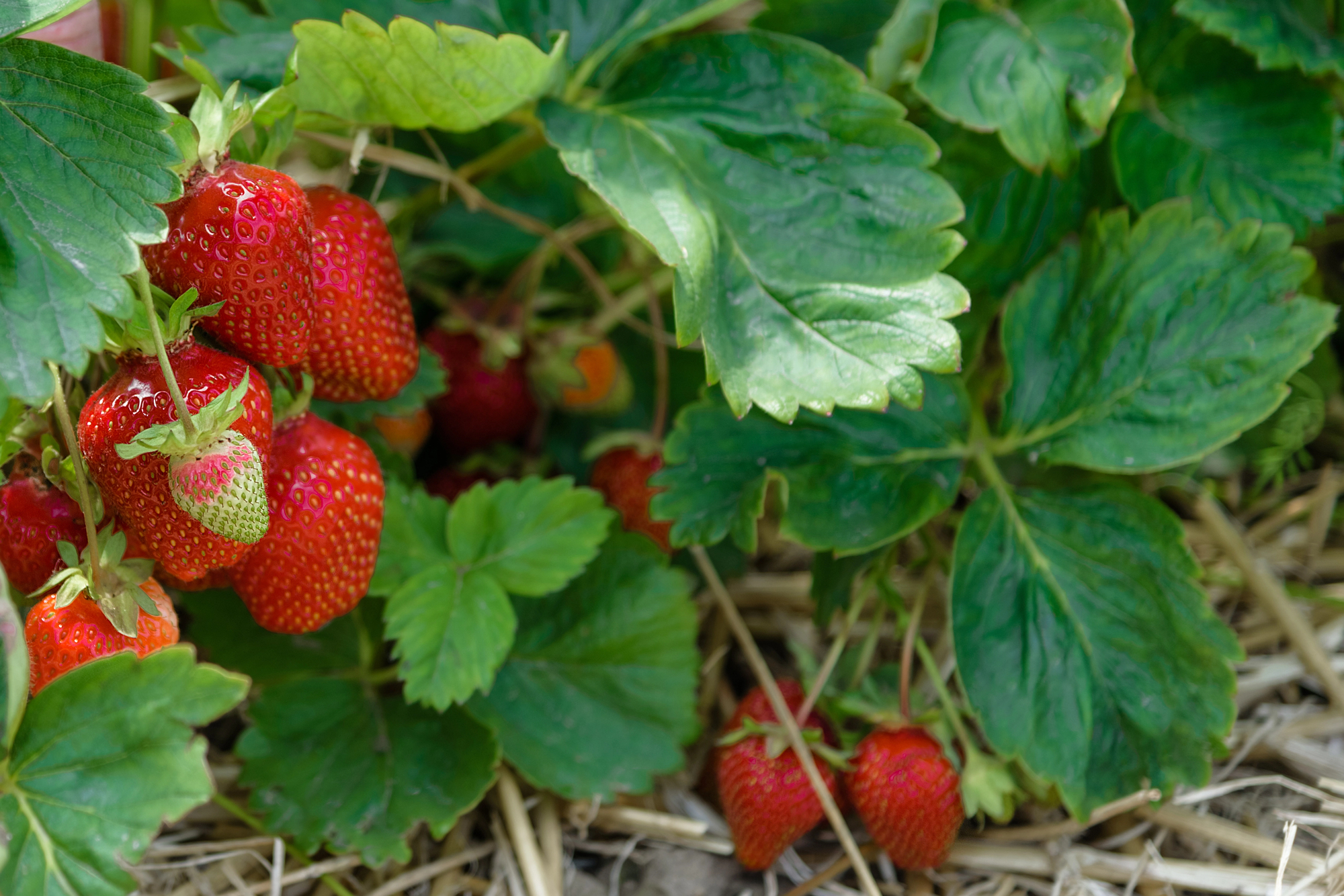Berry Donation Tracker
Quick Links: How & Where to Grow | Temperature | How to Care For | Harvest Signs | Harvesting | Renovation | Pests | Companions | Varieties | Preservation | Recipes | Michigan Tips | Overwintering | Fun Facts
🌱 How & Where to Grow Strawberries:
- Plant bare-root crowns in early spring as soon as soil can be worked.
- Set crown at soil level – too deep rots, too high dries out.
- Space plants 12-18 inches apart in rows 3-4 feet apart.
- Remove flowers year 1 – let plants establish strong roots!
- Sunlight: Full sun (6-8 hours) for sweetest berries.
- Soil Type: Well-drained, slightly acidic soil with pH 5.5-6.8.
- Soil Amendment: Rich in organic matter – strawberries are heavy feeders.
Choose between June-bearing (one large crop), everbearing (2-3 crops), or day-neutral (continuous) types!
🌡️ Temperature Guidance:
Plant when soil 60°F. Flowers damaged at 30°F. Need winter chill.
- Planting: Wait for 60°F soil for best establishment.
- Growing: Optimal production at 60-80°F.
- Frost protection: Cover blooming plants when frost threatens.
- Winter chill: Need dormancy period for spring fruiting.
- Established plants hardy to -10°F with mulch protection.
Michigan’s spring frosts are the biggest threat – have row covers ready!
💧 How to Care for:
- Consistent Moisture: 1-2 inches weekly – critical during fruiting.
- Watering: Use drip irrigation to keep berries dry and disease-free.
- Mulch: Straw mulch keeps berries clean and soil moist.
- Fertilizer: Feed after renovation and again in late summer.
- Runner management: Control runners for larger berries or let spread for more plants.
📏 Harvest Signs:
Fully red with no white. Seeds turn brown. Aromatic. Pick when dry.
- Color: Completely red including tip – no white or green.
- Seeds: Change from white/green to brown when ripe.
- Firmness: Slight give but not soft or mushy.
- Aroma: Sweet strawberry scent intensifies when ready.
- Berries don’t ripen after picking – wait for full color!
Morning harvest after dew dries provides best quality and storage!
🧺 Harvesting:
Pick with green cap attached. Handle gently. Harvest every 2 days in peak season.
- Pinch stem 1/4 inch above berry – don’t pull fruit.
- Keep caps on until ready to use for better storage.
- Use shallow containers to prevent crushing.
- Sort while picking – remove any damaged berries.
- Cool immediately – field heat reduces storage life.
✂️ Renovation (June-bearing):
After harvest: Mow, narrow rows, thin plants, fertilize, water.
- Mow leaves 1-2 inches above crowns within a week of harvest end.
- Narrow rows to 12-18 inches wide by tilling edges.
- Thin remaining plants to 4-6 inches apart.
- Fertilize with 10-10-10 after renovation.
- Water well to encourage new growth.
- Skip renovation for everbearing and day-neutral types.
🪲 Michigan Pests:
Birds, slugs, tarnished plant bug, gray mold, leaf spot.
- Birds: #1 pest – use netting when berries start turning.
- Slugs: Hide under mulch – use beer traps or iron phosphate.
- Tarnished plant bug: Causes misshapen berries – row covers help.
- Gray mold: Worst in wet weather – space plants well.
- Spotted wing drosophila: New pest – harvest promptly.
🫱🏽🫲🏼 Companions:
Good with lettuce, spinach, beans, borage. Avoid brassicas, nightshades.
- Lettuce and spinach: Grow well between rows early season.
- Bush beans: Fix nitrogen for hungry strawberries.
- Borage: Said to improve strawberry flavor and deter pests.
- Avoid brassicas: Compete for nutrients.
- Keep away from: Tomatoes, peppers – share verticillium wilt.
🍓 Varieties:
June-bearing: ‘Jewel’, ‘Honeoye’. Everbearing: ‘Ozark Beauty’. Day-neutral: ‘Seascape’, ‘Albion’.
- ‘Jewel’: June-bearing, late season, large berries, excellent flavor.
- ‘Honeoye’: June-bearing, early, very productive, good for freezing.
- ‘Allstar’: June-bearing, mid-season, disease resistant.
- ‘Ozark Beauty’: Everbearing, good for Michigan.
- ‘Seascape’: Day-neutral, produces all season, heat tolerant.
🫙 Preservation:
Freeze whole or sliced. Make jam. Dehydrate. Fresh only 3-5 days.
- Freezing: Hull berries, freeze on trays, then bag when solid.
- Fresh storage: Refrigerate unwashed in covered container 3-5 days.
- Jam/preserves: Classic way to preserve June’s bounty.
- Dehydrating: Makes sweet strawberry “chips.”
- Freeze in sugar: Traditional method for pie filling.
🧑🏽🍳 Recipes:
Strawberry shortcake, jam, pie, fresh with cream, strawberry-rhubarb crisp.
- Classic strawberry shortcake with homemade biscuits.
- Strawberry-spinach salad with poppyseed dressing.
- Strawberry rhubarb pie – Michigan favorite!
- Fresh strawberry ice cream.
- Strawberry lemonade for summer picnics.
✋🏼 Michigan Tips:
- Plant early April for best establishment before heat.
- Use floating row covers for frost protection during bloom.
- Michigan’s June-bearing varieties produce during perfect weather.
- Raised beds improve drainage in heavy clay soils.
- Replace beds every 3-4 years for best production.
- U-pick farms abundant – support local growers!
❄️ Overwintering:
Winter mulch essential in Michigan! Apply after ground freezes.
- When: Apply 4-6 inches straw after several hard freezes.
- Material: Clean wheat straw is best – avoid hay with weed seeds.
- Spring removal: Gradually remove as growth begins.
- Leave some: Keep mulch between rows for berry protection.
- Row covers: Additional protection in extreme cold.
🧠 Fun Facts:
- Strawberries are the only fruit with seeds on the outside!
- Average strawberry has 200 seeds.
- Not actually berries – they’re “aggregate accessory fruits.”
- Ancient Romans used strawberries for medicinal purposes.
- California produces 75% of U.S. strawberries.
- Strawberries are members of the rose family.
- Native Americans mixed strawberries with cornmeal to make strawberry bread.
- The largest strawberry on record weighed 10.19 ounces!


0 Comments